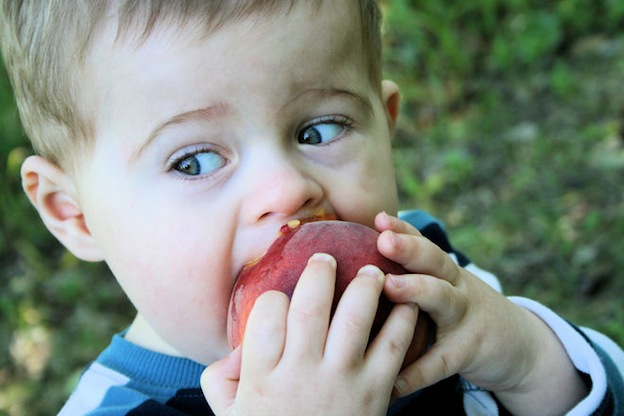SingaporeMotherhood | Baby & Toddler
September 2015
Encourage a Healthy Body Image for your Child

In a world constantly bombarding us with images of “perfect bodies” and “hot bods”, it is almost inevitable that our children are exposed to body-related insecurities even at a young age.
For confident children, a changing body may not be a big deal. But for those who aren’t quite as emotionally secure, the pressure to conform to a perceived stereotype may lead to eating disorders such as anorexia nervosa, bulimia nervosa, and binge-eating disorders. Research has shown that early detection and parental intervention can help nip eating disorders in the bud and lead to fast and effective treatment for children who have them.
[banner][/banner]
Whether it’s an obsession with the bathroom scale, or an unsustainable fitness regime, here are 10 warning signs to look out for:
1. Sudden weight loss or weight gain
2. Sudden change in eating habits
3. Obsessing over calorie counts and nutritional facts
4. Frequent complaining about feeling full or bloated, or having diarrhoea, stomach pain, and vomiting
5. Over-exercising (to lose weight)
6. Distorted body image
7. Going to the bathroom immediately after meals
8. Spending a lot of time in the bathroom
9. General moodiness
10. Low self-esteem

As the saying goes, prevention is better than cure. As parents, we can take proactive steps to help our kids cultivate a healthy body image even before they march into the turbulent waters of adolescence.
Here are just some ways to arm your child with positive attitudes towards food as they progress through the different age groups:
Toddlers and Preschoolers
This is a good age to cultivate good eating habits. Young children have a naturally good relationship with food so this is an excellent time to introduce them to the joy of eating healthy, nutritious meals.
Marcia Herrin and Nancy Matsumoto, authors of the book The Parent’s Guide to Eating Disorders caution against labelling foods as “good” or “bad”. It is not unusual for well-educated parents to be pushy in restricting what is perceived to be the latter but sometimes, their good intentions may backfire. “In fact, not only does restricting foods not result in a decreased desire for those foods on the part of the child,” write the authors, “but she will eat these foods when they become available even when she is not hungry.”
Young children are always keen to imitate their parents so we should take the chance to examine our own relationships to food and set good examples of healthy eating. By avoiding negative self-talk and learning to be comfortable with our own bodies, we can show, through example, the importance of what lies within.
Lower Primary Children
At this stage, children still pretty much model themselves after their parents. Parents should focus on healthy habits for the whole family rather than over-emphasising weight targets or introducing ideal or worse, fad diets.
Let us teach our children healthier coping mechanisms rather than offering them an ice-cream when they are upset. Instead of using food to punish or reward, teach your child to identify her feelings and talk through her problems. Encourage open discussions about body shapes, especially if you sense that your child is developing a negative body image.
 Image cc licensed (CC by 2.0) Flickr image by Personal Creations
Image cc licensed (CC by 2.0) Flickr image by Personal Creations
Upper Primary Children and Teenagers
Parents need to be especially aware of their children’s inner world at this stage. Shy and insecure girls who are especially sensitive to peer pressure may be at risk for copying other popular kids’ disordered eating, so as look as “thin” or “model-like” as them. Skinny boys start exercising compulsively to buff up so they look like “jocks”.
On the other end of the spectrum, kids who are over-achievers or perfectionists tend to set high and unrealistic standards for themselves. Unfortunately, these standards often apply to how they look.
Parents should be watchful around the onset of puberty. Remind your teens in a non-intrusive way that changes to the body are normal and expected. Arm your children with knowledge and the ability to think critically about the waifish actresses and sculpted male models that are plastered across magazine covers and television screens. If possible, purge these images from your home.
Since it is not possible to raise your child, isolated, in a hamlet high up in the mountains, the most effective preventive measures you as a parent can take are to reduce, if not eliminate, the undesirable influences that your child faces. Perhaps then, the most valuable thing we can offer our children is the gift of self-esteem.
Self-esteem is closely tied to body image. Children with low self-esteem find it hard to think well of their abilities and themselves. They take little or no joy in doing well and tend to be critical when appraising their bodies. High self-esteem, on the other hand, is a cultivated immunity against the risk factors that modern living presents.
The good news is that as parents, we can start the process even before they leave the cocoon of our care. Praise your child for his inner qualities as well as his appearance. Be warm, attentive, empathetic, and open. Self-confidence and self-acceptance require regular and consistent deposits in your child’s emotional bank account. Be the person who makes that early investment.
Gwen Lee is the author of several children’s books, such as Little Cloud Wants Snow!—which is being used by schools in Texas, USA, to teach children about weather science. Her latest book of Singaporean Nursery Rhymes Jack and Jill at Bukit Timah Hill is out in stores now. Visit her website for songs and more.
All content from this article, including images, cannot be reproduced without credits or written permission from SingaporeMotherhood.
Follow us on Facebook, Instagram, and Telegram for the latest article and promotion updates.





